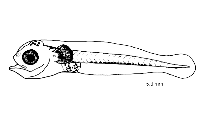| In early larvae, pigment patch above midbrain, patch above nape, pigment series lacking on dorsal margin of tail, and pigment on pectoral fins (widespread on blade, becoming concentrated distally); pigment on first dorsal fin, patch on opercle, and distinctive saddles begin forming in postflexion; 5 saddles in pelagic juveniles (anterior 3 directed anteroventrad); preopercular, parietal, postocular, and other head spination moderately developed.
Pigmentation:
Preflexion: initially, dorsolaterally on gut, 6 - >12 in patch above midbrain, 2 - >5 on nape, 13-18 in series on ventral margin of tail (from about postanal myomere 4 through 17); by about 5.8 mm, on pectoral fin blade (becomes localized distally by end of stage).
Flexion: patch above forebrain.
Postflexion: by about 9.0 mm, on pelvic fins, row beginning to form posteriorly on each side of second dorsal fin base, and 8 or fewer in series on ventral margin of tail (row above posterior end of anal fin base to caudal peduncle); by about 11.0 mm, linear patch along first dorsal base (extending onto fin membrane), and patch on opercle; by about 12.0 mm, on lower jaw tip, on hypural margin, short series on lateral midline in caudal peduncle region (some specimens), and saddle forming at nape; by about 14.0 mm, saddle forming below 4th-7th dorsal fin spines; by about 16.0 mm, on snout, and continuous on dorsum at dorsal fin base; by about 18 mm, on posteroventral margin of orbit.
Pelagic juvenile: by about 26 mm, 3 more saddles forming (at 10th-13th dorsal fin spines, at middle of second dorsal fin, and in caudal region), nape and first dorsal fin saddles directed anteroventrad, most of first dorsal fin membrane covered, becoming restricted to distal margins of pectoral and pelvic fins, on lateral midline anteriad to anal fin insertion, and lacking on ventral margin of tail; by about 34.0 mm, nearly lacking on pectoral and pelvic fins, more on snout, and beginning to cover epaxial region of body.
Sequence of fin development: pectorals and caudal, dorsal and anal and pelvics.
Also Ref. 34817. |
